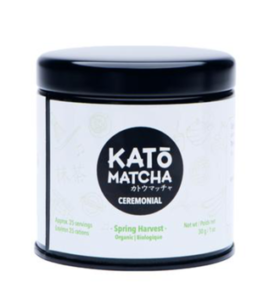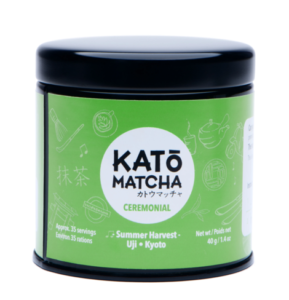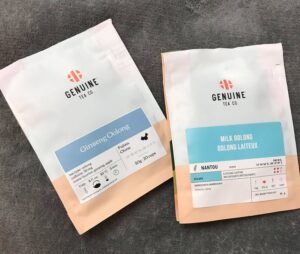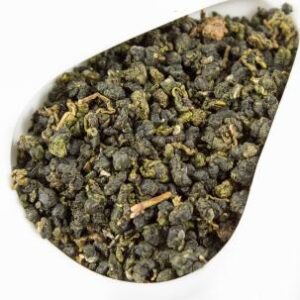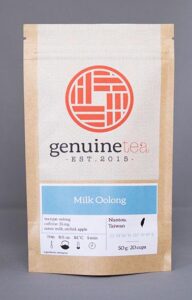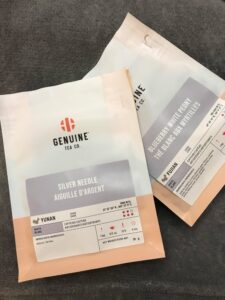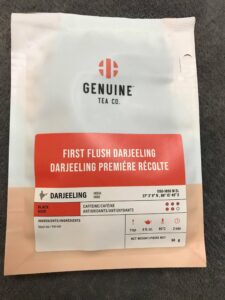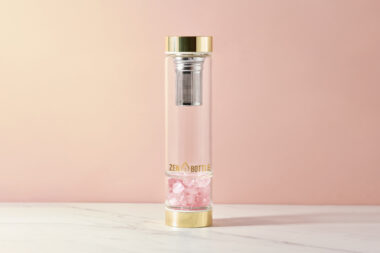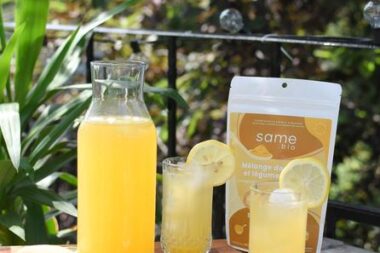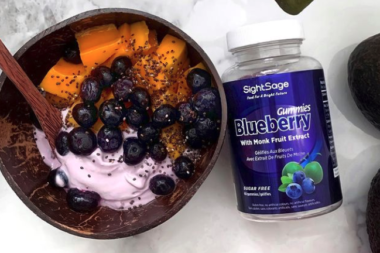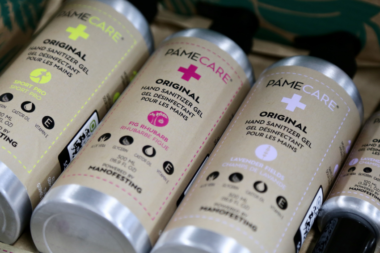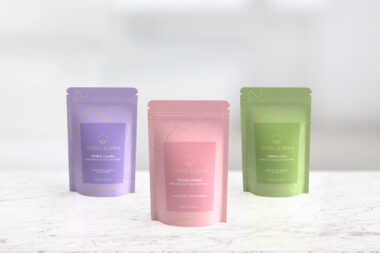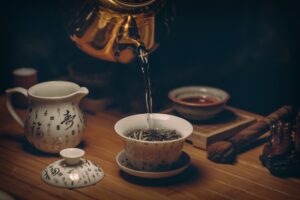 Lovers of tea and lovers of adventure, David & Sarah travel the world in search of premium loose-leaf teas. Being a Brit, Dave drank his cuppas on the regular and Sarah soon became a tea addict too. Together they spent nearly 5 amazing years in Taiwan, studying Mandarin and discovering the wonders of hand-crafted artisan teas. After several visits to plantations across Asia and a wealth of tea knowledge under their belts, they returned to Canada with a simple dream – to share their love of tea and adventure with others through Genuine Tea Co.
Lovers of tea and lovers of adventure, David & Sarah travel the world in search of premium loose-leaf teas. Being a Brit, Dave drank his cuppas on the regular and Sarah soon became a tea addict too. Together they spent nearly 5 amazing years in Taiwan, studying Mandarin and discovering the wonders of hand-crafted artisan teas. After several visits to plantations across Asia and a wealth of tea knowledge under their belts, they returned to Canada with a simple dream – to share their love of tea and adventure with others through Genuine Tea Co.
“The North American tea industry is headed in the same direction as the specialty coffee and wine industries and we are excited to be leading this movement in Toronto. By practicing direct trade and focusing on attributes such as region, elevation and harvest date, we are helping to close the gap between the tea in your cup and the people who dedicate their lives to producing it.” – David O’Connor, Co-founder
“The thing I love about tea is that every culture enjoys it in their own unique way. Tea has led me on an incredible journey throughout Asia and I can’t wait to keep discovering more of the world through tea.” – Sarah Wilcox, Co-founder
Here are some of Genuine Tea Co.’s featured teas:
Kato Matcha – Organic Spring Harvest – From the Katō Family in Uji, Kyoto to your cup. This is a perfectly smooth ceremonial grade organic certified spring harvest from the finest growing region in Japan.
The spring harvest is regarded as the highest quality with very little astringency. It has a strong umami flavour with a delicate sweetness. The Katō Matcha Spring is such high quality that it drinks perfectly on its own as a tea.
Kato Matcha – Summer Harvest – The Katō Matcha Summer is perfect for the daily Matcha drinker, it pairs excellently with a dash of milk, as a latte or in your morning smoothie.
Preparation for the Katō Matcha Spring & Katō Matcha Summer:
1) Sift* half a teaspoon of Katō Matcha Summer into a preheated vessel
2) Add 1oz of 75ºC water
3) Whisk to create a consistent level of foam
4) Top up with desired amount of hot water or steamed milk
*the sifting process is not crucial; it simply helps break up the tea evenly and ensures a more consistent Matcha paste
Oolong gets its name from the words “wu long” or 烏龍 in Mandarin which, translated means “black dragon.” This term is often used to describe a serendipitous mistake – a fortune wrapped in a riddle – and that is an excellent way of describing the complexities of Oolong tea. The leaves unfurl and dance around allowing the richness of its heady liquor to be enjoyed over multiple infusions.
Ginseng Oolong – This exquisite oolong from Fujian has been oxidized between to approx. 40% before being rolled in stone-milled ginseng. It exudes sweet and creamy notes that complement the natural floral taste of the oolong.
Ginseng is a great source of natural energy and when paired with this spring harvest oolong, will keep energy levels up and keep you calm throughout the day.
Region: Fujian, China | Elevation: 800m
Serving: 3g | Temp: 85C | Steep time: 4-5min
Ingredients: milled ginseng, oolong tea
Milk Oolong comes from the Jin Xuan cultivar grown in Taiwan. It has a beautiful floral aroma with a smooth, milky taste.
Legend has it, the moon saw a comet flying through the night sky. The moon quickly fell in love with the beauty and elegance of the comet however, the comet met upon a cruel fate as it entered the earth’s atmosphere. The moon became very upset and, in her sadness, she blew a cool wind through the mountains over the tea fields. When a tea farmer awoke the next day, he found that the cool wind had created a sweet milky flavour in his tea leaves – the ‘Jin Xuan’ Oolong, aka Milk Oolong was born.
Our Milk Oolong is a favourite among tea enthusiasts, it can be steeped multiple times and the full, hand-rolled leaves unfurl fully in your cup.
Tasting Notes: Orchid, Apple, Cream
Region: Nantou, Taiwan | Elevation: 1000m
Serving: 3g | Temp: 90C | Steep time: 3-5min
Ingredients: oolong
Herbal teas are essentially any tea that does not contain the Camellia Sinensis plant. They are caffeine-free but still exciting in their own right. There is nothing more soothing than sipping on a nice warm cup of Evergreen Peppermint in the evening or curling up with a good book and a cup of rooibos tea on a rainy day.
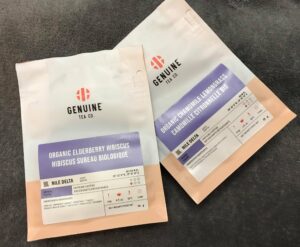
Organic Elderberry Hibiscus and Organic Chamomile Lemongrass
Organic Elderberry Hibiscus – Organic Ontario elderberries blended with Egyptian hibiscus – it doesn’t get more refreshing than this! This tea is one of our top sellers in the summer. It has a delicate sweetness and a beautiful tartness that make it comforting in the colder months and a phenomenal refreshment in the warmer months. A fan favourite!
Organic Chamomile Lemongrass – Organic Egyptian Chamomile has been consumed for centuries for its health benefits and as a sleep aid. Chamomile is great for relaxing muscles, soothing stomach cramps and can even help fight bacterial ailments. Blended with Lemongrass, this tea provides a beautiful floral aroma with a mild citrus finish. This tea is perfect bedtime and will gently calm you to sleep.
White tea is the least processed of all tea types. It has been plucked by hand and dried in natural sunlight locking in its delicate, sweet flavour. Lovers of white tea will often say that sipping on its beautiful coppery liquor evokes an emotional experience that is more than simply drinking tea. White teas can lift your spirits, calm your nerves and transport you to a tranquil space.
Blueberry White Peony – White teas are the least processed of all the tea types. They are simply picked and withered in natural sunlight then briefly piled and baked to ensure that the moisture is removed. This step prevents any further oxidation and enzyme activity. Our Blueberry White Peony is made from the delicate and grassy Bai Mu Dan aka “white peony” from Fujian province. It by hand-blended in Toronto with blueberry, currants, elderberries and hibiscus to create a lightly sweet and refreshing flavour profile.
Silver Needle – Harvested in the spring in Yunan Province, this tea consists of beautiful buds covered in a silvery down. Also known as Bai Hao Yin Zhen, this is one of the most prized teas in the world. The buds are plucked and placed in shallow bamboo baskets and dried in sun. This quick drying process allows for very little oxidation. Silver Needle has beautifully complex notes of chamomile and peach and can be re-steeped multiple times. For the best experience use the perfect water temperature and about 6-8oz of water.
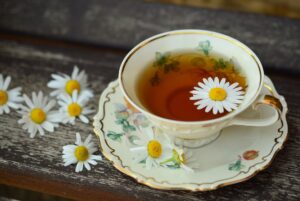 Black Tea sometimes gets a bad reputation however, this is truly unfounded. All tea comes from the Camellia Sinensis plant and therefore contains a whole host of similar properties. After the tea leaves have been plucked, withered and rolled, they are allowed to oxidize. As the oxygen in the air combines with the remaining moisture in the leaves, they darken. This process leaves a beautiful rich liquor that can include notes of sweet berries, honey and cocoa.
Black Tea sometimes gets a bad reputation however, this is truly unfounded. All tea comes from the Camellia Sinensis plant and therefore contains a whole host of similar properties. After the tea leaves have been plucked, withered and rolled, they are allowed to oxidize. As the oxygen in the air combines with the remaining moisture in the leaves, they darken. This process leaves a beautiful rich liquor that can include notes of sweet berries, honey and cocoa.
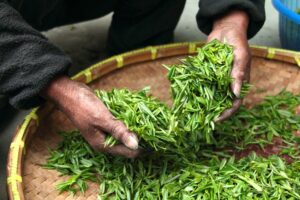 Known as ‘The Champagne of Teas’ this high mountain First Flush Darjeeling has an incredibly complex flavour profile that seems to evolve from sip to sip.
Known as ‘The Champagne of Teas’ this high mountain First Flush Darjeeling has an incredibly complex flavour profile that seems to evolve from sip to sip.
Grown in the high elevations of the Himalayan hill region, this tea drinks more like a partially oxidized oolong rather than a black tea. It has strong notes of melon, grapes and pear.
Known in the tea world as an ‘FTGFOP1’ – this is the highest grade of tea in India. This acronym stands for ‘Finest Tippy Golden Flowery Orange Pekoe’ although, some tea connoisseurs joke that it stands for ‘Far Too Good For Ordinary People’. The First Flush or Spring Harvest is considered the finest of all the harvests as the leaves are still young, very flavourful and incredibly nutrient rich.
Darjeeling First Flush – Darjeeling is well known for its small and gentle leaves as it comes from the Camellia Sinensis Sinensis varietal rather than the more common Camellia Sinensis Assamica varietal.
Darjeeling tea cultivation has a relatively short history and only began when civil surgeon Arthur Campbell began planting some Chinese tea seeds in 1841. Shortly after, the British began planting nurseries and establishing a tea industry in order to compete with China.
Tasting Notes: Muscatel Grape, Malt, Pear
Region: Darjeeling, India | Elevation: 1200m
Serving: 3g | Temp: 90C | Steep time: 2-3min
Ingredients: black tea
All teas are available on the website for purchase.

